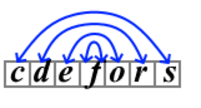311358: CF1974B. Symmetric Encoding
Description
Polycarp has a string $s$, which consists of lowercase Latin letters. He encodes this string using the following algorithm:
- first, he constructs a new auxiliary string $r$, which consists of all distinct letters of the string $s$, written in alphabetical order;
- then the encoding happens as follows: each character in the string $s$ is replaced by its symmetric character from the string $r$ (the first character of the string $r$ will be replaced by the last, the second by the second from the end, and so on).
For example, encoding the string $s$="codeforces" happens as follows:
- the string $r$ is obtained as "cdefors";
- the first character $s_1$='c' is replaced by 's';
- the second character $s_2$='o' is replaced by 'e';
- the third character $s_3$='d' is replaced by 'r';
- ...
- the last character $s_{10}$='s' is replaced by 'c'.
 The string $r$ and replacements for $s$="codeforces".
The string $r$ and replacements for $s$="codeforces". Thus, the result of encoding the string $s$="codeforces" is the string "serofedsoc".
Write a program that performs decoding — that is, restores the original string $s$ from the encoding result.
InputThe first line contains a single integer $t$ ($1 \le t \le 10^4$) — the number of test cases.
The first line of each test case contains a single integer $n$ ($1 \le n \le 2 \cdot 10^5$) — the length of the string $b$.
The second line of each test case contains a string $b$ of length $n$, consisting of lowercase Latin letters — the result of encoding the original string $s$.
It is guaranteed that the sum of the values of $n$ over all test cases in the test does not exceed $2 \cdot 10^5$.
OutputFor each test case, output the string $s$ from which the encoding result $b$ was obtained.
ExampleInput5 10 serofedsoc 3 ttf 9 tlrhgmaoi 1 w 15 hnndledmnhlttinOutput
codeforces fft algorithm w meetinthemiddle
Output
波利卡普有一个由小写拉丁字母组成的字符串s。他使用以下算法对字符串进行编码:
1. 首先构建一个新的辅助字符串r,其中包含字符串s中所有不同的字母,按字母顺序排列;
2. 然后进行编码:字符串s中的每个字符都被字符串r中的对称字符替换(字符串r的第一个字符将被最后一个字符替换,第二个字符将被倒数第二个字符替换,依此类推)。
例如,对字符串s="codeforces"进行编码的过程如下:
- 获得字符串r="cdefors";
- 第一个字符s1='c'被's'替换;
- 第二个字符s2='o'被'e'替换;
- 第三个字符s3='d'被'r'替换;
- ...
- 最后一个字符s10='s'被'c'替换。
因此,对字符串s="codeforces"进行编码的结果是字符串"serofedsoc"。
编写一个程序,进行解码,即从编码结果中恢复原始字符串s。
输入输出数据格式:
输入:
- 第一行包含一个整数t(1≤t≤10^4)——测试用例的数量。
- 每个测试用例的第一行包含一个整数n(1≤n≤2×10^5)——字符串b的长度。
- 每个测试用例的第二行包含一个长度为n的字符串b,由小写拉丁字母组成——原始字符串s的编码结果。
- 保证所有测试用例中n的值的总和不超过2×10^5。
输出:
- 对于每个测试用例,输出从编码结果b得到的原始字符串s。题目大意: 波利卡普有一个由小写拉丁字母组成的字符串s。他使用以下算法对字符串进行编码: 1. 首先构建一个新的辅助字符串r,其中包含字符串s中所有不同的字母,按字母顺序排列; 2. 然后进行编码:字符串s中的每个字符都被字符串r中的对称字符替换(字符串r的第一个字符将被最后一个字符替换,第二个字符将被倒数第二个字符替换,依此类推)。 例如,对字符串s="codeforces"进行编码的过程如下: - 获得字符串r="cdefors"; - 第一个字符s1='c'被's'替换; - 第二个字符s2='o'被'e'替换; - 第三个字符s3='d'被'r'替换; - ... - 最后一个字符s10='s'被'c'替换。 因此,对字符串s="codeforces"进行编码的结果是字符串"serofedsoc"。 编写一个程序,进行解码,即从编码结果中恢复原始字符串s。 输入输出数据格式: 输入: - 第一行包含一个整数t(1≤t≤10^4)——测试用例的数量。 - 每个测试用例的第一行包含一个整数n(1≤n≤2×10^5)——字符串b的长度。 - 每个测试用例的第二行包含一个长度为n的字符串b,由小写拉丁字母组成——原始字符串s的编码结果。 - 保证所有测试用例中n的值的总和不超过2×10^5。 输出: - 对于每个测试用例,输出从编码结果b得到的原始字符串s。